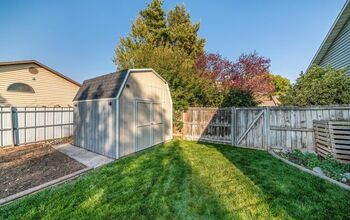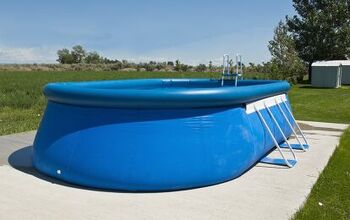Can You Put A Normal Trampoline In The Ground?

Trampolines are an orthopedic surgeon’s worst nightmare and a kid’s best friend. Can you take your normal trampoline and put it in the ground? Will this make it safer?
You can put a normal trampoline in the ground as long as your city approves digging an adequately-sized hole. Because soil collapses over time, we recommend building a retaining wall to prevent the ditch from degrading. Measuring and digging for this project is everything- if you lack the proper tools or expertise, call in a professional.
Continue reading to discover if it’s possible to put a normal trampoline in the ground. We’ll also discuss how to complete this process and decide which trampoline version is safer!
Is It Possible to Put a Normal Trampoline in the Ground?
Trampolines are both fun and semi-dangerous. I can count on two hands how many friends I had in middle school that broke a bone jumping on one.
The million-dollar question is- can you put a normal trampoline in the ground?
It’s possible to put a normal trampoline in the ground with the right method and expertise, of course. While you may feel fit for the job, we recommend hiring a professional to ensure it’s done right.
This process involves digging the proper-sized hole and securing your preexisting trampoline to the Earth. Any lapse in technique can create additional safety concerns.
Obstacles Involved in Putting a Normal Trampoline in the Ground
Converting a normal trampoline to an in-ground version may seem like a daunting task, and it’s important to remember that most outdoor projects have their challenges.
Here are the main obstacles involved:
- You must leave space for the trampoline to drain, which can create a tripping hazard.
- Soil collapses over time, increasing the risk of people hitting the ground when they jump.
- Digging a hole adds to the cost of the process.
- Your measurements have to be perfect so that your trampoline fits and is buried adequately.
- You may need to add a retaining wall and a sump pump.
How to Put a Normal Trampoline in the Ground
Typically a professional or trained home enthusiast can install a trampoline in the ground within a day or 2. The cost varies based on whether or not you opt to go the professional installation route.
If you choose to install it yourself, prices start at around $500 for the equipment and can exceed $1500 with expert-level assistance.
Here are the following steps for installing a normal trampoline in the ground:
- Notify your city of digging plans.
- Map out the hole.
- Check the weather and start digging.
- Confirm the integrity of the soil.
- Add a sump pump or some form of drainage.
- Insert your trampoline.
- Fill the hole with soil.
- Add padding or landscaping around the perimeter.
We’ll talk more about the specifics of each below.
Notify Your City of Digging Plans
First and most importantly, call your city to let them know you’re going to be digging a rather large hole in your yard.
Sometimes you need their approval, and they’ll be able to advise on which areas to avoid- if there’s underground piping or lines you don’t know about, etc.
Map Out the Hole
This requires some serious mathematics and exact measurements.
The easiest way to plan for a circular trampoline is to find the circumference and mark for the hole that way. Although less common, if you have a square or rectangular-shaped trampoline, you can use a measuring tape.
You want to leave about 3 inches around the perimeter to allow for drainage or space for the sump pump.
Check the Weather and Start Digging
You want to make sure it’s not going to rain, as this will put a damper on your digging efforts (literally).
Digging the hole can be done with a tractor and by hand with a shovel. Additionally, you may be able to hire a contractor to do this part of the job for you.
Just make sure the forecast shows clear blue skies before you start!
Confirm the Integrity of the Soil
Sometimes the deeper you dig, the less stable the subsoil layers are.
If you don’t have a firm infrastructure that will hold long-term, consider adding a retaining wall. While this takes more time and adds cost to the project, it will be worth it in the long run.
Add a Sump Pump or Some Form of Drainage
Like we mentioned above, you need some form of drainage for your in-ground trampoline. Without this, water will collect on top and damage it, or air will be trapped beneath the surface.
Installing a sump pump or simple surface drainage pump is the perfect solution, although it can get complex. For this reason, specifically, we recommend hiring a professional.
Just make sure your hole is able to accommodate the pipes that need to be installed.
Insert Your Trampoline
Once your hole is dug, and the drainage system is in place, you can lower your trampoline in the hole.
Make sure it’s centered, and there’s an even amount of space around the perimeter. The goal is to have the trampoline slightly elevated (an inch or so above the hole) to make backfilling easier and allow for a bit of soil compression.
Fill the Hole with Soil
Next, you need to throw the soil that was removed back in!
This will create stability for the trampoline and make it easier for the grass to grow back around it.
Add Padding or Landscaping Around the Perimeter
This step is optional.
Some parents wish to add some padding around the border of the trampoline. It prevents injury and finishes off the look of the space. Just keep in mind that you still need to make sure there’s room for air and water to escape.
Additionally, you can replant grass or add additional plants to make the trampoline blend better with your yard!
What Type of Trampoline Is Safer?
This is really an in-ground versus above-ground question.
Technically speaking, in-ground trampolines are a little bit safer due to the fact that they’re closer to the surface of your yard. That way, if a child does fall, there’s not a long way down.
However, if you jump high in the air, there’s still a pretty big chance you get hurt. If you want an additional layer of safety, you can always add a net to reduce the risk of injury.
Related Questions
Is a trampoline good exercise?
A trampoline can be great exercise if you use it for long enough.In fact, 10 minutes on the trampoline is equivalent to a 30-minute run when it comes to burning fat. There are even workout classes designed around utilizing trampolines.
Can an in-ground trampoline be installed on a slope?
While this can be done, it’s not recommended.Slopes make the springs on a trampoline uneven and can dramatically increase the chance of getting injured.
Can a normal trampoline stay up in the winter?
As long as you live in an area that doesn’t get much snow, a normal trampoline can remain in your yard!Cold weather doesn’t damage a trampoline, but moisture and wind can degrade the metal components over time.
In Summary
To wrap things up, it’s possible to put a normal trampoline in the ground with proper preparation.
In order to keep your trampoline (and your kids) safe, you’ll need to make sure that there is clearance for any pipes or other drainage equipment, along with ensuring there’s an even amount of space around the perimeter. This will help with backfilling and give your grass a chance to grow around the trampoline frame.
If you feel unprepared to complete this job alone, never hesitate to call in a contractor!

Emily is a copywriter with over five years of experience in crafting content for the home renovation and remodeling industry. She loves house projects, whether it be painting a room or tweaking small design elements to transform a space. Her favorite aesthetic is french modern because of its clean lines and airy feeling! When not writing, Emily loves to travel and check out architectural details all over the world.
More by Emily Carr














![How Much Weight Can a 4×4 Support Horizontally? [It Depends!]](https://cdn-fastly.upgradedhome.com/media/2023/07/31/9070333/how-much-weight-can-a-44-support-horizontally-it-depends.jpg?size=350x220)












